Download the Tail Spend Management Handbook
Table of Contents
Introduction to Tail Spend
Tail Spend refers to all the unmanaged high-volume and low-value transactions that take place within an organization. Tail Spend Management actively manages maverick spending by consolidating 80% of suppliers who account for 20% of procurement spend and thus positively impacts the firm’s financial performance due to its impact on operating margin.
Simfoni.com Tweet
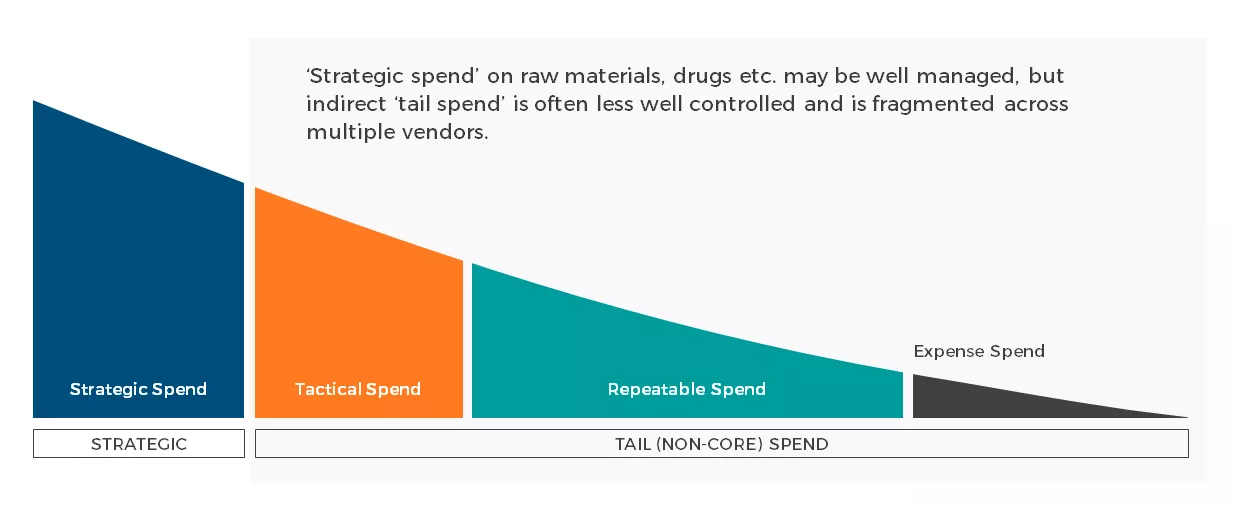
Today, procurement departments face immense pressure to conduct responsible purchasing when commodity prices are volatile, and supply market risks are at an all-time high. And while tail spend is a familiar concept, it’s rarely correctly optimized.
Regardless of size, every organization has encountered tail spend issues whether they realize it or not. While this type of spend can be harmless in small doses, having your tail spend management under control can become a key competitive advantage.
For example, when the economy is experiencing a downturn and cost-cutting is a high priority, the best savings opportunities lie in indirect spend areas such as tail spend. Procurement departments must recognize the areas that they could be using resources inefficiently and leaving money on the table due to low-value spending.
So what is the big issue with tail spend? And why do organizations have to understand just how much money is involved? Simply put, a key strategy to overall cost management and savings is to bring tail spend under control. You cannot manage what you can’t see.
That said, let’s explore in detail what tail spend is about and how you can leverage it in your business.
The Pareto Principle
Created in the 19th century by economist Vilfredo Pareto the Pareto Principle is today’s golden rule in procurement.
Our discussion on tail spend cannot begin without going into detail about the Pareto Principle. Essentially, tail spend is based on the Pareto curve or 80/20 rule. When applied to procurement, the rule states that 80% of the Total Spend is made with only 20% of the vendors.
So the remaining 20% of the spend (consisting of high-volume, low-value transactions) uses 80% of the vendors. That 80% represents a significant number of transactions by a large number of vendors and creates a long unmanageable tail that keeps growing.
The rule is handy for spend segmentation and helps sourcing professionals determine where to focus their attention.
What is Tail Spend?
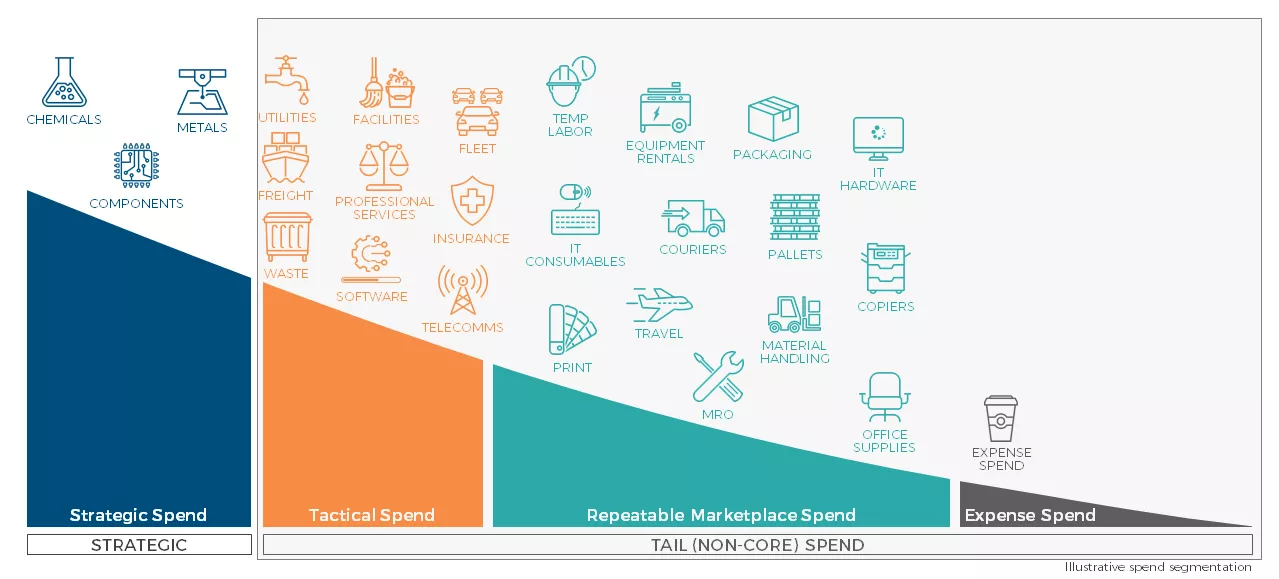
So what exactly constitutes tail spend?
The definition has changed over the years. Today, tail spend refers to ad hoc spending and uncategorized supplier purchases that are low in volume, frequency, or value. This is the reason why most companies don’t prioritize tail spend management.
Tail spend has many names; it is sometimes referred to as rogue spend or maverick spend. Generally, tail spend involves small value or invisible purchases that an organization makes outside of the contracts they have with their core suppliers and often outside of the awareness of the procurement team.
It may involve millions of dollars spread across hundreds or even thousands of suppliers. However, it is often overlooked as a source of significant savings when procurement cost savings are brought up.
But tail spend does not include low-value transactions only. In some organizations, it can consist of significant high-value purchases that are undertaken by a department to speed up a need within the business.
This has negative consequences for the procurement, finance, and warehouse team, who are often left to deal with paperwork reconciliation, locating the arrival of stock, and identifying who has undertaken the transaction. An additional problem with mismanagement of tail spend is that purchases conducted outside of contract expose the organization to the risk of non-compliance and fraud.
It’s important to note that while this is the general view of tail spend, the definition of what constitutes tail spend varies from organization to organization. For some, tail spend in itself is not the issue per se; however, the fact that it is mainly invisible and unmanaged means there are certainly missed opportunities for savings occurring in the organization.
Types of Spend in Procurement
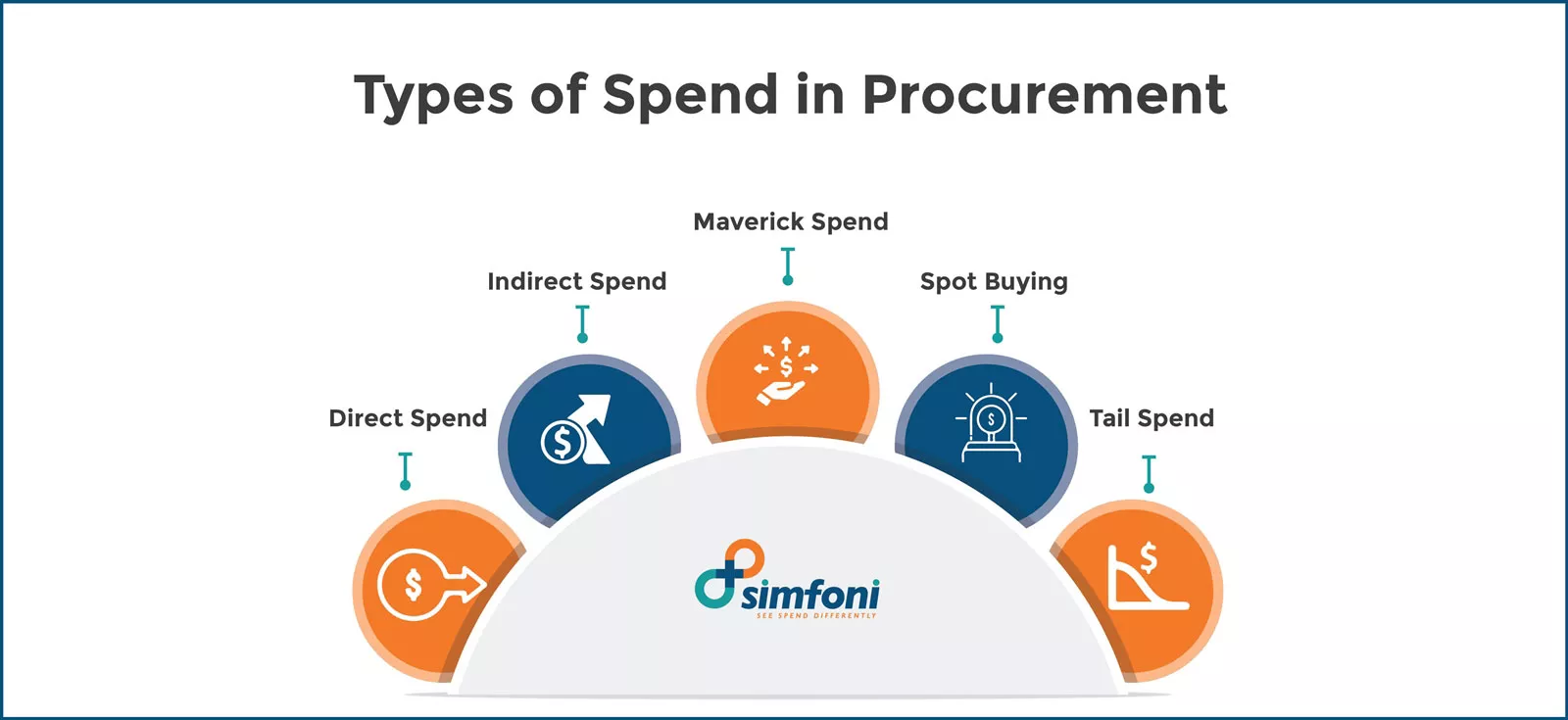
To understand the solutions for proper tail spend management, you first need to know the types of spend that exist in procurement.
Many organizations need to engage in data-driven decisions when it comes to spend. This requires a clear understanding of the types of spend that occur in procurement. Tail spend specifically can fall into several spend categories such as:
- Marketing services
- Print and packaging
- Business services
- Signage and display
- Professional services
- Facilities
- Uniforms and Apparel
- Office products
- Gifts and premiums
- Temporary labor
The types of spend in procurement include the following:
1. Direct Spend
Direct spend, also called direct procurement, can include costs that are directly associated with purchasing raw materials and goods related to production. In most organizations, direct spend typically represents the most significant percentage of total spend annually.
Some activities related to direct spend include; vendor risk management, supplier relationship management, logistics and inventory management, and logistics. So how can direct spend be managed better?
The best way to accomplish this is by carefully examining the direct procurement team’s close partnerships with its supply base. This is an area with great potential for innovation within the supply chain. Additionally, taking a closer look at the spend analytics of purchase orders will help identify trends and areas where improvements can be implemented to leverage buying power.
2. Indirect Spend
Indirect spend or indirect procurement refers to operating expenses and overhead costs that cannot be directly included with the total cost of the end product. We can further classify indirect spend into more categories. For example, indirect spend categories include the following:
- Operations: office equipment and supplies, transportation, food, and beverage.
- Services: professional services, facilities maintenance, marketing, travel, entertainment, and human resources.
- Technology: Software, telecommunications, hardware, storage.
How can organizations better manage Indirect Spend?
Many procurement departments lose sight of spend visibility in purchases falling under the indirect spend category. This opens the door to tail and maverick spend because if each department is negotiating contracts outside of procurement’s purview, it can lead to a lot of unnecessary spending.
Again a proper examination of Maverick and tail spend in your organization can help identify low-hanging fruit for cost-savings opportunities. This analysis will also help you identify purchasing redundancies, highlight potential compliance issues, and bring to light opportunities to renegotiate with existing vendors and suppliers.
Another bonus tip is to first categorize every transaction and purchase as either direct or indirect spend. This will give you a complete picture of how your organization spends money.
3. Maverick Spend
Maverick spend occurs when purchases are made outside of the organization’s procurement guidelines. With Maverick spend, the company also does not benefit from the negotiated preferred pricing contracts with suppliers, quality standards, negotiated volume discounts, and supplier credibility. Maverick spend results in lost opportunities while increasing the risk of compliance issues.
Maverick spend has more to do with other departments not following a defined process rather than with the item or supplier.
In conclusion, Maverick spend occurs when:
- Procurement is decentralized.
- Purchasing systems are lengthy, or the rest of the organization is unfamiliar with them.
- Purchasing controls are lacking.
- There’s no product standardization.
- A purchase is made outside the preferred channel or supplier.
- Purchases do not follow set procurement contract terms or negotiated pricing.
- Purchases are considered too small or insignificant to matter.
How can you manage your maverick spend better? Sometimes specific departments in the organization can bypass procurement guidelines because it’s seen as a gatekeeper to a product or service that a department feels strongly about.
Most maverick spending can be managed by forming partnerships and educating internal stakeholders in the various departments. By working together with stakeholders, procurement teams can help reduce maverick spend and find cost-savings opportunities for other resources.
4. Spot Buying
Generally, spot buying is a type of emergency spend that occurs when a department or organization is trying to meet an immediate need. Spot buying is said to account for nearly 40% of all indirect spend. Organizations need to account for spend that occurs when they periodically need to purchase items that have not been planned for one reason or another.
It’s impossible to altogether avoid spot buying, as it’s pretty common for other divisions in the organizations who are end-users of a product (like replacing a broken stapler) to make unplanned purchases once in a while. Usually, an organized procurement department would not engage in spot buying frequently or at all.
To summarize, spot buying occurs when:
- There is an emergency
- The item is small and inexpensive
- The purchase in unplanned
- The item is used infrequently – therefore purchased in lower volumes
- It is a unique purchase
So how can you manage spot buying better? The best way is to capture spot buying activity as it occurs. This ensures compliance with all corporate procurement processes. For instance, Simfoni’s one vendor payment aggregates all low-value and non-core or indirect spend, enhancing visibility and control over all spend with consolidated payments that address the costly transactional burden of managing hundreds or thousands of small vendors.
5. Tail Spend
Lastly, we have tail spend, also known as tail-end spend or long-tail spend, which describes the invisible or unaccounted spend in an organization. For example, maverick spend is often classified as a form of tail spend.
Tail spend is the term used to define the amount of money that an organization spends on purchases that make up approximately 80% of transactions but only 20% of total spend volume. As we’ve stated before, what constitutes tail spend varies by category and by the organization.
For instance, tail spend could be machine parts for industrial-goods companies, specialty chemical materials for chemical companies, and office supply items for banks. The number of tail spend items will vary as well.
Tail spend occurs:
- In low volume purchases.
- Once-off or infrequent purchases.
- Low-value purchases.
Keep in mind that tail spend differs for each organization. Therefore you should identify your organization’s tail spend so procurement can take the necessary steps to optimize it.
Most organizations need to curtail unnecessary spend by reducing spot buys, controlling maverick spend, and managing tail spend. Each type of spend procurement can be optimized to yield better results. Finally, understanding what contributes to each can help you recognize the importance of controlling indirect spend.
Difference Between Maverick, Rogue, and Tail Spend
Is there a Difference Between Maverick, Rogue, and Tail Spend?
Maverick Spend, Rogue Spending, and Tail Spend are common, often interchangeable terms in procurement. However, there are slight differences in the definitions. For example, rogue spend can be defined as unpredictable, while Maverick is more or unorthodox or independent spend.
All three terms are used to describe and define any spend that is outside the managed structure and guidelines set by procurement. Therefore all three types of spend contain many forms of un-managed transactions and purchases.
Examples of Tail Spend
So what exactly are we talking about in terms of the items, purchases, and transactions that fall under all these different types of spend? Below we’ve compiled a few examples of spend that reside within the tail spend category.
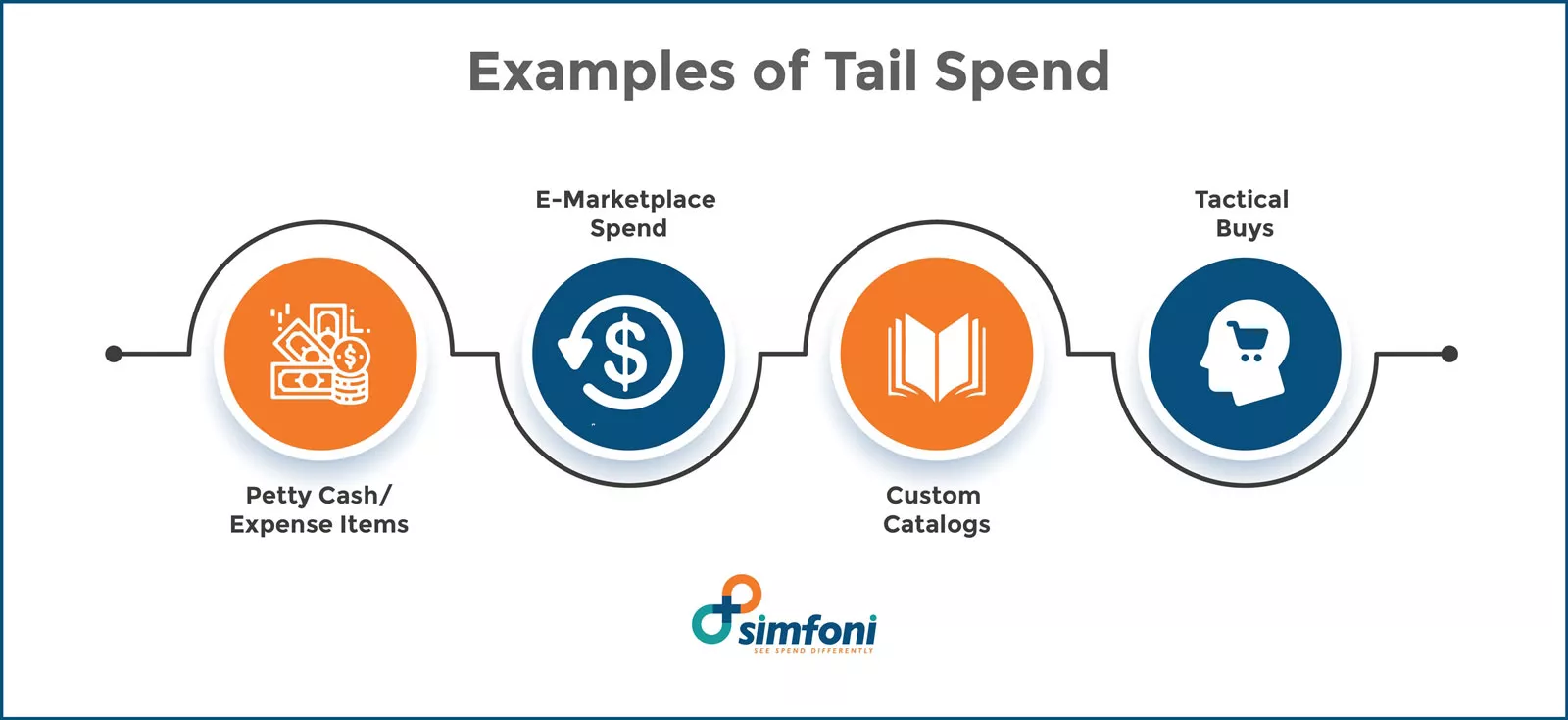
1. Petty Cash/Expense Items
At the bottom of the tail spend chain are the day-to-day expenses that an organization needs to operate. Most of these purchases or transactions are made out of the office. So, for example, these could include:
- Lunches
- Taxis
- Fuel
- Sundry items related to travel or on-the-job spot expenses like a replacement power cable for an employee who forgot on the plane.
2. E-Marketplace Spend
Next up the chain is marketplace spend. This type of spend comprises the most standard and repeatable purchases common in all organizations. Companies buy these items all the time and don’t really give much thought to negotiating prices or any cost-saving terms because they are deemed not of material value.
Marketplace spend typically accounts for about 5 to 10% of a company’s total third-party spend. However, these purchases represent about 90% of a company’s transactions. Hence, the speed and efficiency of the transaction are far more critical. Examples of marketplace spend include:
- Stationery (office paper and pens)
- Batteries
- Power tools
- Paper cups
- Laptops
- Office furniture (desktop fans, tables, and chairs)
3. Custom Catalogs
Things get a bit confusing here. For example, in a manufacturing business, it’s common to purchase a lot of power tools. In this case, the shop floor department will care about which power tools they have access to and how much they cost. The power tools, in this instance, are a particular business requirement. However, some companies may not have any custom catalog spend, but this type of spend can be as much as 15% in cases where there are.
4. Tactical Buys
The next type of spend up the chain are tactical buys which are similar to spot buys. The difference is more easily explained by defining tactical buys and then distinguishing how spot buys are different.
Tactical buys are defined as purchases that are known only to the user. Simply put, the items have been bought before, and the vendor or vendor base is known. They are different from custom catalog spend because the frequency of purchase is lower and does not warrant the establishment of a particular procurement framework or agreement.
An excellent example of a tactical buy is forklift batteries. The particulars of the items are precise, and it’s something that is replaced periodically. Spot buys, on the other hand, are usually once-off purchases. Tactical buys typically represent around 15-25% of an organization’s spend.
Tail Spend Management
Tail Spend Management includes controlling and mapping purchasing expenditure at all non-strategic suppliers. Tail spend management enables companies to achieve a more efficient supplier base and better insight into expenditure and savings.
In a perfect world, corporations would be able to manage all types of transactions and purchases regardless of size. While tail spend management is slowly gaining the spotlight, most organizations don’t even know how or why they should manage their tail spend. This is due to several reasons.
Challenges of Tail Spend Management
You see, tackling tail-end spend is rather daunting, not least because of the sheer number of suppliers involved. It’s also not commercially viable to undertake a successful tail spend management strategy.
Additionally, tail spend comprises purchases of such low value. They are usually placed either via telephone, email, apps or on a third-party website, meaning they are outside the procurement framework in place and therefore invisible.
Tail spend, therefore, consists of these one-off type purchases or transactions that hardly take place often enough to be added into the cataloged system. And if they are categorized, the system tends to be complex and hard to classify, especially without a technology solution. The old way of tracking tail spend across Excel spreadsheets is burdensome on employees and resources.
Another issue is that most procurement professionals are trained to handle high-profile purchases, critical strategic initiatives, and high-volume buys that align with the corporate vision and are essential to the company’s growth. Typically, these purchases are tied to large core contracts with specialized terms which leverage the company’s buying power and specify terms of use.
On the other hand, more minor or insignificant purchases tend to be less controlled and vary from department to department. Some procurement departments allow different divisions within the organization some autonomy and leeway to make low-value purchases. This leaves the other departments that aren’t the procurement division to use their own system and judgment.
On the surface, this might seem like a good idea, so for example, the administration department could be better equipped to negotiate a stationery deal that saves the company money. Until it is revealed that the purchase and its associated contract overlapped an existing corporate agreement. This will cause a threshold miss of a larger volume discount and put the company at greater compliance risk.
Another challenge to proper tail spend management occurs when the existing procurement processes are broken or cumbersome. In this instance, employees will improvise and do what it takes to get the job done, especially if purchasing is not their primary function. Again this jeopardizes compliance and cost savings because these employees don’t have the training or experience of the procurement professionals who take best practices into account.
To give you a better understanding of why some spend goes un-managed. How the problem can get worse over time we have compiled a few scenarios below:
- Employees believe that their purchases are too small and will have no impact on their overall bottom line.
- There’s no formal procurement process for smaller transactions, or the existing process is too cumbersome and complicated.
- The company’s management is too focused on large spend items.
- Management projects a fixed percentage of tail spend, not realizing that it’s not a static figure.
- Ineffective contract management results in overlapping or duplicating contracts on similar items, which negatively impacts the whole procurement system.
- Too many vendors make it difficult to effectively manage the relationships, and no major initiative is taken by management as it may require a significant increase of manpower and committed resources, and the cycle goes on.
So what are the possible solutions that procurement can bring to the organization to help speed up the procurement process and allow colleagues to purchase low-value items?
Why Is It Important to Manage Tail Spend?
Part of keeping a competitive edge in today’s economy involves procurement activities and improved spend management. Un-managed spend makes planning and forecasting complicated, inaccurate, and incomplete.
Managing costs and key supplier relationships contribute directly to bottom-line profits. When a business has complete control of indirect, spend they can introduce various cost-saving strategies and help improve their operating costs.
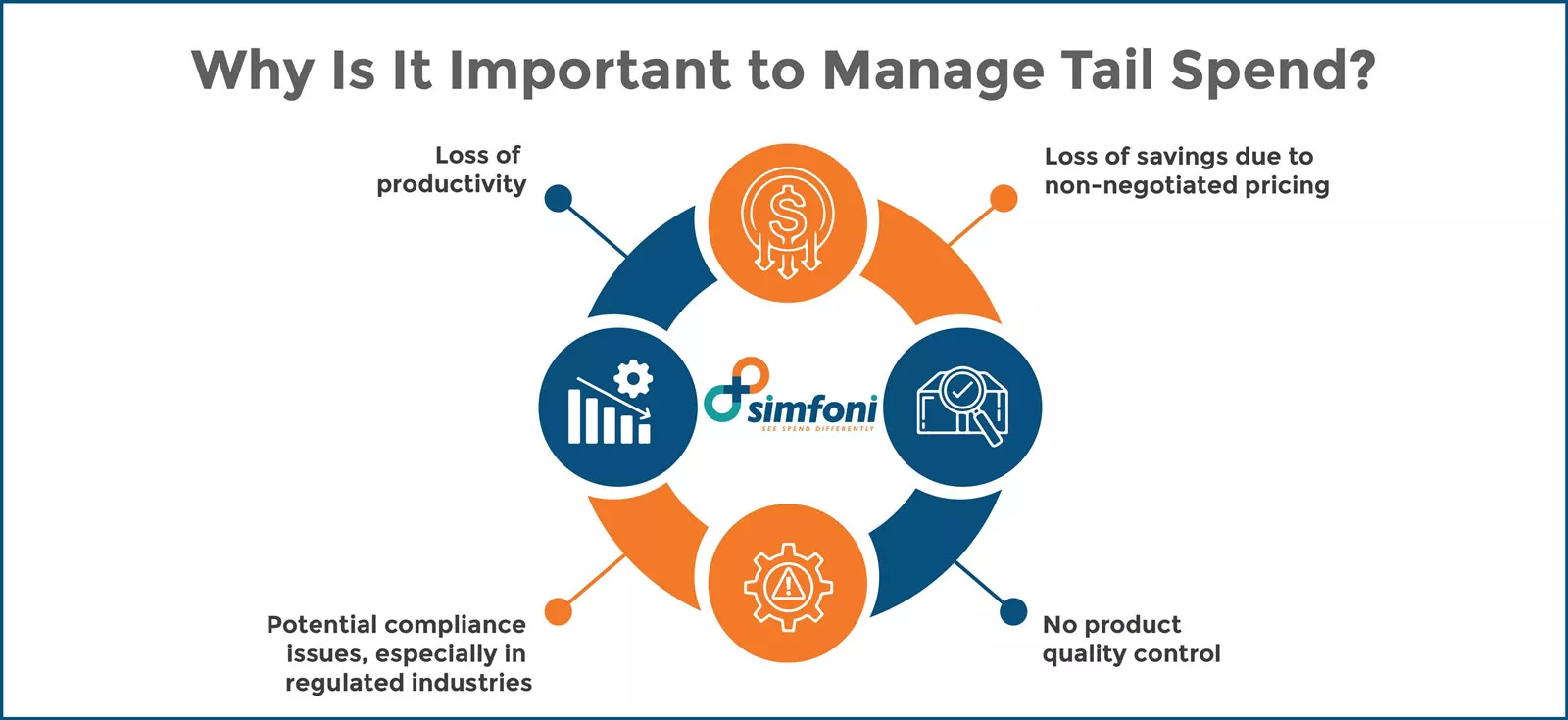
Several issues are created when an organization cannot control its tail spend. Mismanagement will lead to critical issues including:
Loss of savings due to non-negotiated pricing
Companies tend to pay higher prices for small products that can be obtained much cheaper at negotiated pricing by the procurement department. Pre-negotiated costs often result in savings of about 20-30% of total indirect spend by an organization.
No product quality control
Lack of tail spend management does not only mean paying a higher price for items; it could also result in loss of product quality control. The risk of inferior quality products significantly increases and can harm the company’s reputation.
Potential compliance issues, especially in regulated industries
When the number and quality of suppliers are unmanaged, compliance risks tend to become an issue. For example, it’s pretty easy for contracts and payment terms to conflict.
Loss of productivity
Time is wasted on unnecessary transactional buying activities that aren’t adding value to the company. Research has shown that organizations can lose as much as 40% in buyer and requester productivity by chasing these purchases.
Benefits of Managing Tail Spend
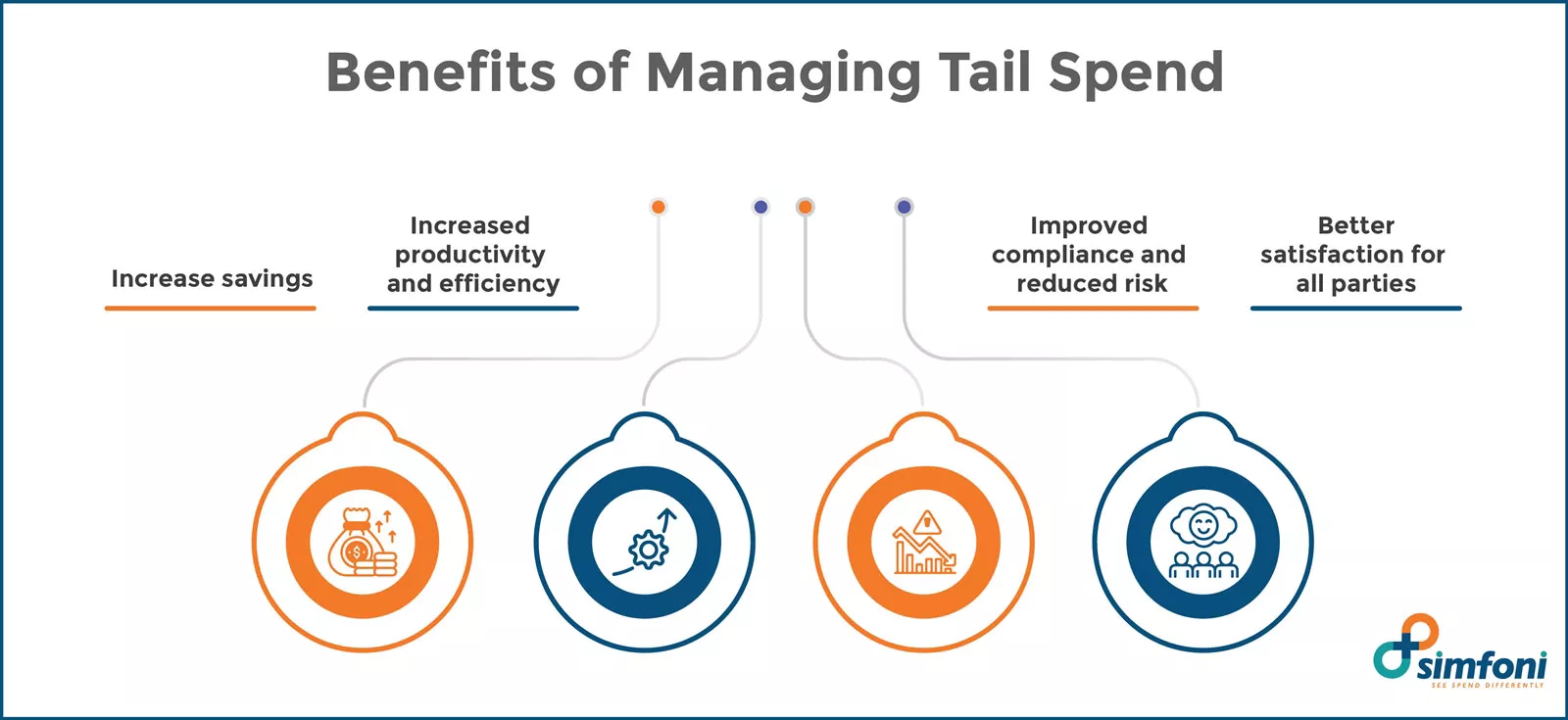
1. Can increase savings
Companies that focus on managing tail spend can realize a one-time savings of about 10 to 20% when spending is addressed first. An additional 2 to 5% of savings is expected thereafter annually. Generally, we recommend that you should aim to have at least 86% of their total spend in the strategically managed category.
2. Increased productivity and efficiency
Tail spend management helps organizations to consolidate the supplier base, and this increases efficiency. This reduces the number of suppliers that procurement has to deal with while reducing costs. Consolidated management also gives procurement more time to spend on larger contracts that add more value to the business.
Having better catalog coverage and self-service procurement also allows the procurement team to focus on value-adding tasks. By clearly identifying opportunities for continuous improvement, the procurement function can increase productivity by up to 20%.
3. Improved compliance and reduced risk
Another benefit of tail spend management is the improvement of compliance with business policies and contract terms, both on the part of business users and vendors. By getting rid of unreliable suppliers from the base, the risk is significantly reduced. In addition, the procurement process becomes more transparent, allowing for easy prevention and detection of fraud.
Tail spend management digital systems should be implemented to control, monitor, and track transactions as they occur. This means exceptions can be found as they happen and addressed before being sent to the supplier.
Unlike traditional methods, these softwares effectively prevent rogue spending and provide the organization with detailed insights into spend behavior. This way, you can ensure that up to 95% of purchases with your company are compliant with policies and contracts.
4. Better satisfaction for all parties
Internally and externally, parties are often more satisfied because the systems are easy to use. Tail spend management clarifies who is responsible for what and the contact person or people for various issues. This results in reduced process cycle times and up-skills procurement resources.
To summarize, analyzing and tracking spend is essential for the following reasons:
- You can manage and increase the spend coverage.
- Low-value spend becomes visible.
- Maverick spend and unnecessary transaction costs are reduced and, in some cases, eliminated.
- Management leads to better data quality and improvement of the procurement process.
- Business, compliance, and fraud risk are reduced as the contract coverage expands.
- You can eliminate trivial suppliers who are often the reason for the rise in costs.
- You can lessen the procurement functions that tend to increase spend.
While proper tail spend management does have immediate benefits, full identification, implementation, and analysis will take time.
What is Tail Spend Analysis?
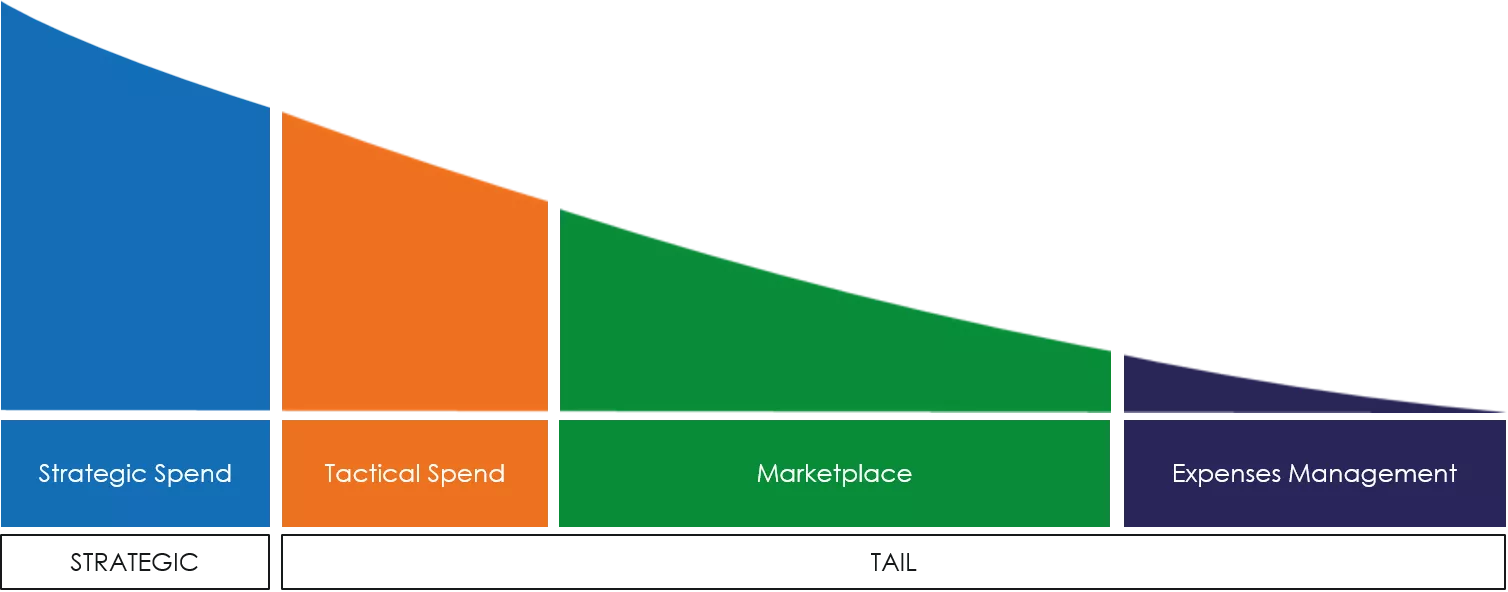
Organizations that take proactive action can gain a competitive advantage by significantly trimming costs. One way of accomplishing this is using technology. According to a study by Boston Consulting Group, companies that use technology to actively manage tail spend were able to cut annual expenditures by up to 10%.
Our Tail Spend Management Solutions at Simfoni actively manages maverick spending by consolidating 80% of suppliers who account for 20% of procurement spend. Thus, it positively impacts the firm’s financial performance due to its impact on operating margin. This is called the Pareto Principle, and we discussed it in detail earlier on.
Simfoni’s tail spend management software also gives you a complete view of all crucial factors such as category, vendor, purchase threshold, or other important metrics. It provides insights into what you’re doing right and what you could do better, identifying such spending and extracting information of the tail spend from the reports.
The software also sets up automatic KPIs to rate performance. It allows customization based on the size and type of your business as well as the industry. Remember that analyzing your corporate tail spend will require a year’s worth of data for the best results.
Why is Spend Tracking and Analysis So Important?
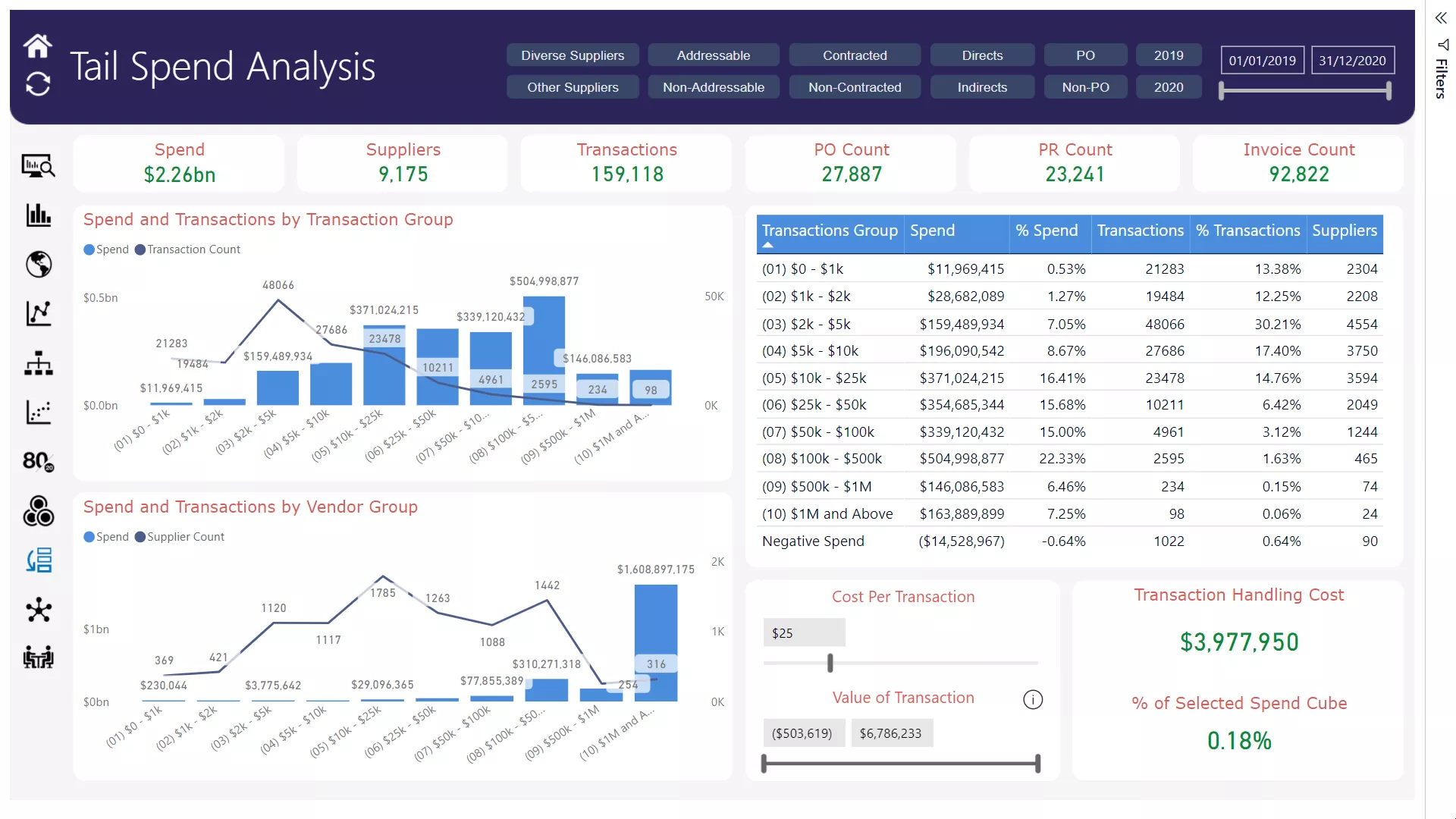
An essential component of managing tail spend is efficient spend tracking and analysis. Ultimately your business will need a spend tracking, and analysis tool to reap the many benefits of tail spend management.
The rapid integration of technology and AI in spend tracking today is allowing more and more organizations an opportunity to capture and visualize in real-time their tail spend data. As a result, the company can adapt and plan effectively, saving a lot of money.
How To Analyze Spend Using Tail Spend Management Framework
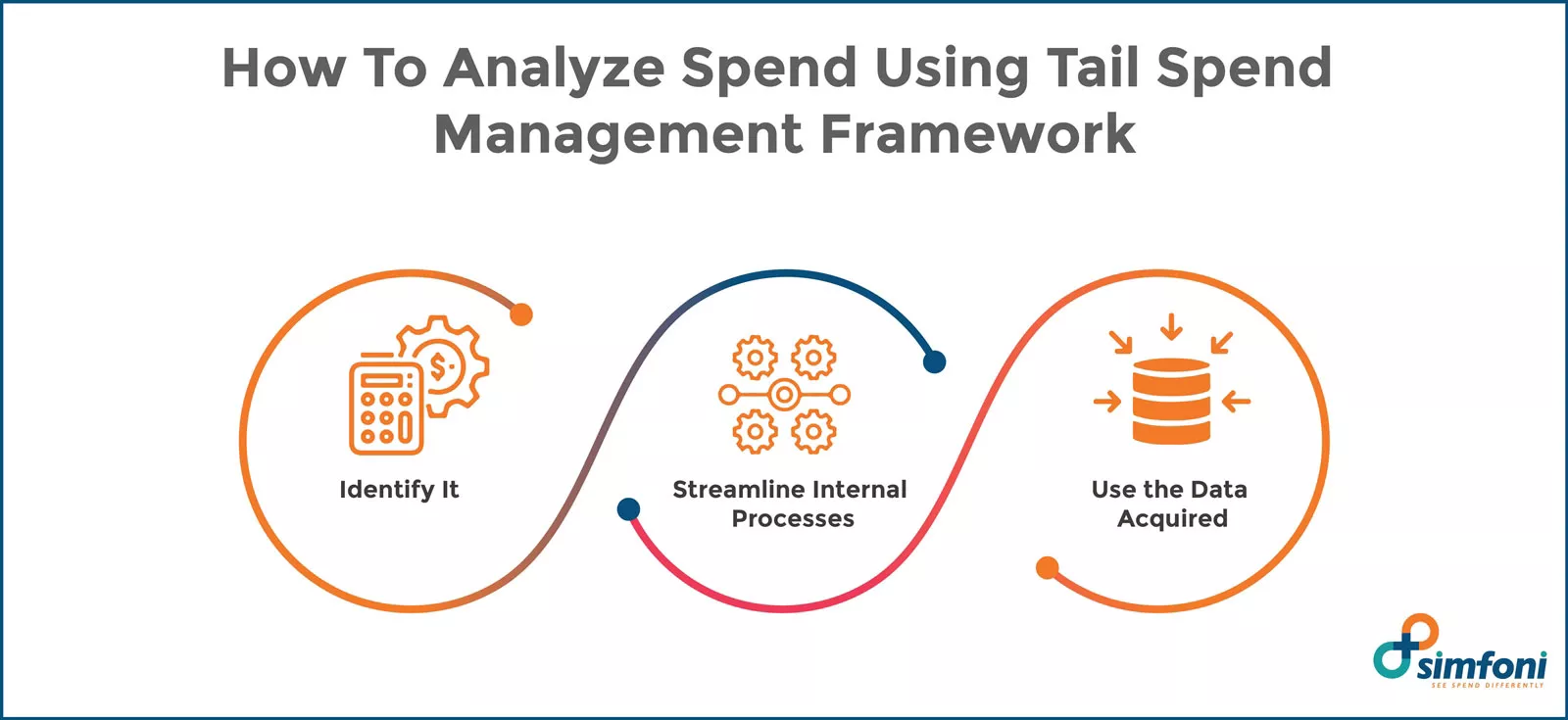
1. Identify It
Tail spend is a broad category. Since tail spend analysis can incorporate anything from misclassified purchases to maverick spend, it’s crucial to characterize what it is and where it is going in your company. Again keep in mind that the definition can and tends to vary slightly depending on the organization.
- The first step to identifying tail spend is to retrieve the spend data from all sources and analyze it.
- Once this is complete, the next step is to define tail spend as it relates to the specific organization.
- Lastly, you’ll need to calculate your tail spend based on that definition. This is done by calculating the ratio of spend to suppliers. For the purposes of this calculation, tail spend is classified as all purchasing vendors other than the 20% that have the highest spend.
Once the first three steps are completed, you’ll need to segment tail spend commodities and start to look for savings opportunities, in the form of cost reduction and cost avoidance, at the transaction level and the spend level.
The segments are as follows:
- Hidden Tail: You will find the biggest suppliers in this segment. These are generally dealt with as part of strategically managed spend, where negotiated and monitored contracts are in place. However, some of the spend is hidden as the contracts don’t always cover the specific materials or services being purchased or because of non-compliant spend.
- Head of the Tail: In this segment lies spend that isn’t strategically managed and sites anywhere between $50,000 to $1 million per year.
- Middle of the Tail: This segment includes purchases that have many suppliers ranging from $2,000 to $200,000 per supplier. Usually, this segment of the tail isn’t strategically managed because the spend per supplier is too small.
- Tail of the Tail: In this segment, you will find suppliers with less than $2,000 spend. The spend is extremely fragmented and transactional because it includes many one-off purchases with a large number of suppliers.
2. Streamline Internal Processes
To manage spend better, it’s essential to streamline all internal processes so that data is more visible, the number of overall suppliers is reduced, and you can keep a close eye on all spending.
Ideally, your organization should have an e-procurement system that requires employees to fill out formal purchase requisitions for approval before converting them to purchase orders. The system should also have an approved vendor list and products to choose from. This will reduce spending outside any strategically managed contracts.
A part of this analysis includes implementing a three to six-month “spot buy reduction” program for all segments of the tail. The end goal should be to move tail spend into strategically managed spend and channel it into catalogs or other automated buying channels.
Ultimately, the goal is to save some money for the organization, so all streamlined internal processes should support this goal.
3. Use the Data Acquired
Once you’ve streamlined the internal processes by identifying, classifying, and examining spend data, it’s time to work on sourcing and contracting to ensure that the majority of purchases and transactions are handled strategically.
After starting out your procurement this way, you’ll need to measure improvement in your tail spend performance using various tail spend KPI metrics such as:
- Cost reduction and avoidance.
- Transactions costs.
- Improved spend visibility.
The key to efficiently using this data is to incorporate big data and analytics, AI, automation, and digital platforms into your tail spend management strategies. Technology solutions can boost the efficiency of key procurement processes, including mass tenders.
Learn more about- eProcurement
Steps for better Tail Spend Analytics.
To ensure that the above tail spend management framework is successful, you should implement additional steps for better tail spend analytics. The framework should have the following:
1. Thorough Spend Analytics
The framework should include steps for a complete spend analysis that identifies all types of spend. These non-compliant transactions ought to be coordinated to existing understandings and other spending to empower compliance.
2. Sourcing Helpdesk
A full-time sourcing helpdesk from a third party acts as a one-stop-shop for all sourcing and acquisition inquiries. Contingent upon agreed-upon spend parameters, every sourcing inquiry should be coordinated to either the client’s in-house sourcing division or existing supplier agreements.
3. Tail Spend Consolidation
Vendor consolidation is another important feature of tail spend management framework. Instead of spreading out and spending across a considerably large group of suppliers, the framework has to focus on a limited number of vendors. This can bring about the following key benefits:
- Reduced complexity: A limited number of suppliers means that there are lesser vendor relationships to manage. Supply-chain managers can then create an automated interaction channel between the suppliers, thus freeing up their time, allowing them to focus on other value-added activities and strategic vendor management.
- Effective Cost-Management: A consolidated vendor base means less money is spent on individual supplier freight charges. Additionally, the internal process costs that are a part of managing large volume transactions with suppliers can be eliminated.
- Supply Continuity: A reduction in the number of suppliers, particularly for low-value materials or low-volume purchases, reduces the chances of delay or non-delivery of orders. Maintaining a consolidated and trusted supplier base has the benefit of suppliers understanding your business requirements and their specificities. Moreover, you’re likely to notice a significant reduction in quality and lead time issues.
4. Online Marketplace Provider
The framework should have provision for approaching an online provider marketplace performing sourcing activities where suitable.
Strategic purchasing
For genuine purchases, fast turnaround benchmarking, offering, and transaction benefits that guarantee all the purchases are contacted by the procurement analytics.
Inclusion of local supply market information
Including information on the local supply market is extremely imperative as this implies expanded comprehension and proficiency, especially as a cost-saving measure for the organization.
How to Reduce Tail Spend Using Simfoni’s Spend Management Platform
We’ve talked a bit about the benefits of using tail spend management software to reduce the burden of tail spend analysis, tracking, and software. Traditionally, however, many businesses simply make tail spend management the responsibility of their internal procurement team.
While doing this achieves several goals such as tighter and more comprehensive controls on purchases adding to the workload of the purchasing department, which may already have limited capacity, is not always the best solution.
That’s where we come in. At Simfoni, we have realized five key factors that tail spend management software has to address. These are:
- The software must help with looking for cost-saving and cost reduction opportunities in procurement.
- It must help you identify and pay attention to ongoing savings.
- The software must facilitate long-term and short-term ROI.
- It must help you control your transactions seamlessly.
- It must reduce risk.
Simfoni’s tail spend software is a useful tool for the management of low-value spend and purchases in an organization. The features include:
- On-Site, Cloud, and cross-device compatibility.
- Large memory and an ability to save data of many individuals and even of those who work in groups.
- Fast speed regardless of volume or amount of transaction.
- Support for emails and phone calls.
Our software makes purchasing easier, captures more spend, provides more visibility and control over tail spend. Moreover, when you consolidate purchases, you can negotiate with vendors to save even more.
The bottom line is this there is no excuse for allowing tail spend fatigue to cause procurement to fall behind.
Benefits of Outsourcing Tail Spend Management
There are several benefits to outsourcing your tail spend management, especially due to the fact that today’s customers have become more demanding. Both external consumers and internal stakeholders within an organization demand more speed in the supply chain, a variety of product choices, visibility into operations, customized orders, and omnichannel flexibility.
For companies looking to optimize supply chain cost, complexity, and capital outsourcing is the best solution for the management of all non-core vendors.
Simfoni’s automated tail spend management does the heavy lifting for you and assumes full responsibility for the procurement, management and supply of inventory from non-core vendors directly to a manufacturer on-demand.
Outsourcing tail spend helps organizations to effectively manage:
- Price Matching
- Distributor Bypass
- Vendor Consolidation
- Lead Time Maintenance
- Efficient Category Management
Tail Spend Management Software
We’ve talked a bit about the benefits of using tail spend management software to reduce the burden of tail spend analysis, tracking, and software. Traditionally, however, many businesses simply make tail spend management the responsibility of their internal procurement team.
While doing this achieves several goals such as tighter and more comprehensive controls on purchases adding to the workload of the purchasing department, which may already have limited capacity, is not always the best solution.
As businesses grow, it becomes increasingly difficult to maintain visibility and manage tail spend. Spend management platforms offer an automated way to handle a company’s spend. A spend software platform saves you both money and time by automating bookkeeping workflows.
Spend management software reduces Tail Spend by:
1. Giving you complete visibility into your spend:
A spend management platform consolidates all of your billing and expenditures into one place to give you a comprehensive view of your spend and budget. A few key features include:
- Tracking spend over time.
- Automatic identification and update of vendors, which employees use them and spend in real-time.
- Using this key data to realign spending around the company’s budget goals.
- Organizing data into tail spend categories to give you better understanding of where the money is going.
- Track any upcoming spend by automatically identifying all active subscriptions and predict upcoming payments.
- Visibility allows you to tailor your budget with ease.
2. Eliminating unnecessary spend
Standard tail spend documentation is spread across purchase orders, spreadsheets, crumpled-up receipts, and lost emails. Conducting proper spend analysis becomes difficult. Spend management platforms helps organizations to centralize spend information and enables accounting teams to catch unnecessary expenses, reducing maverick spend and identify savings opportunities. The platforms do this by:
- Automatic detection of wasteful spending.
- Identification of cost saving opportunities by looking through spend and identify duplicated and unnecessary purchases.
- Using cards ties to your expense platform to control spend. This involves issuing cards with pre-approved spend limits so that enforcement of procurement policies is easier.
3. Block unapproved vendor spend
Traditionally vendor management is time-consuming and labor-intensive. Things are spread across multiple channels, and all approvals have to be done has to be done manually. Spend management platforms centralize and simplify vendor data.
You can:
- Review and approve spend requests in seconds.
- Easily spot overlapping services and suppliers.
- Identify expenses that should be approved and provide a complete visual of the budget, spend, and vendors.
- Predict and control all vendor costs.
- Eliminates waiting for monthly statements as transactions are recorded instantly.
- Easy access to all data for better negotiation with new and old vendors.
4. Automate policy enforcement
A spend management platform can help your organization enforce your spend policies and automate approvals. This reduces tail spend by creating a smooth process saving time for everyone and reducing guesswork.
5. Simplify expense submission and reimbursement
Spend management platform eliminates the need to track down receipts and fill out expense reports. The platforms offer:
- Automated receipt-matching
- Instant notification for cardholders when they swipe by SMS or email.
- Automated reminders, collections, and matches receipts for every transaction that needs one.
- Easy reimbursement policies with automatic receipt verification of 90% of expense reports and one-click approval and deposit processes.
Spend Automation Solution to Manage Tail Spend
Supercharge your procurement with the world’s most accessible spend management platform. From tail spend to total spend, simplify the way your company sources and buys the materials and supplies that it needs.
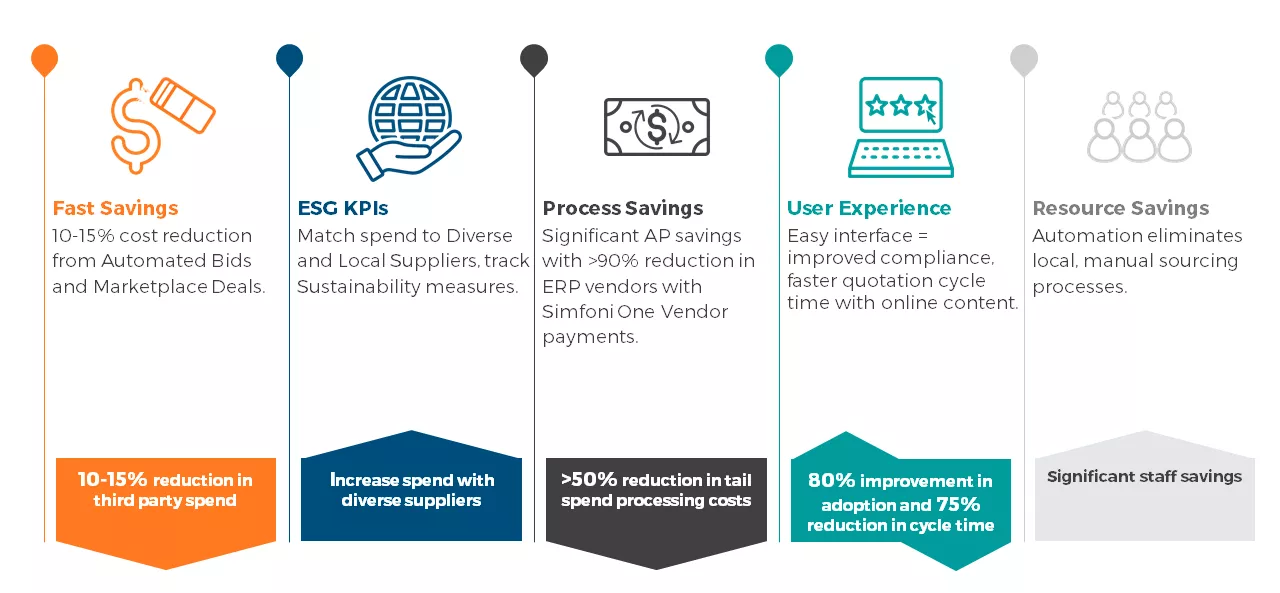
We fuse revolutionary technology, content and deep expertise to help you sky-rocket savings and achieve your sustainability objectives. Smooth and agile workflows eliminate manual tasks and take the headache out of procurement.
With rapid deployment, zero upfront costs and a unique Pay-As-You-Save pricing model we get you up and running in days with best-in-class procurement technology.
Scale up or down and connect with other systems as your needs change. An effortless, fluid, future-ready spend management platform that puts you in control of core and non-core spend. With autonomous buying, vendor engagement, invoice automation and advanced analytics, you get to compose your perfect solution.
It’s not hard to see why businesses around the world choose Simfoni to increase spend under management.
Frequently Asked Question (FAQ)
What does tail spend mean in procurement?
Tail spend in procurement refers to a category of purchases that are characterized by low transaction volume, often involving a large number of suppliers, and typically account for a relatively small percentage of an organization’s total spend. It represents the “long tail” of the spending distribution curve, where numerous small purchases accumulate.
What is an example of a tail spend?
An example of tail spend could include small, infrequent purchases such as office supplies, safety equipment, or janitorial services. These purchases are essential for day-to-day operations but individually contribute little to the overall procurement budget.
How do you analyze tail spend?
Analyzing tail spend involves:
- Data Collection: Gathering detailed data on all procurement transactions, no matter how small.
- Spend Categorization: Categorizing spend items to identify tail spend categories.
- Supplier Assessment: Evaluating the supplier base to identify numerous, low-value suppliers.
- Spend Assessment: Determining the total spend associated with tail spend categories.
- Prioritization: Prioritizing tail spend categories based on strategic importance and potential cost savings.
What is tail spend management strategy?
A tail spend management strategy involves systematically addressing and optimizing the procurement of tail spend items. It includes strategies such as supplier consolidation, automation, and strategic sourcing to reduce costs, improve efficiency, and mitigate risks associated with tail spend.
Why is tail spend management important?
Tail spend management is important for several reasons:
- Cost Savings: Even though individual tail spend items are small, they collectively represent a significant portion of the procurement budget. Managing them effectively can lead to cost savings.
- Efficiency: Streamlining tail spend processes improves procurement efficiency, reducing administrative overhead.
- Risk Mitigation: Managing tail spend helps mitigate risks associated with a large number of suppliers and uncontrolled spending.
- Data Insights: Analyzing tail spend provides valuable insights into spending patterns and can inform broader procurement strategies.
What is the tail spend trend?
The tail spend trend refers to the increasing recognition of the significance of tail spend in procurement and the adoption of strategies to manage it more effectively. Organizations are realizing that addressing tail spend can lead to cost savings, improved efficiency, and reduced risks.
What does long-tail spend mean?
Long-tail spend is another term for tail spend. It’s called “pareto principle” because of how the spending distribution curve looks. In this curve, you have a small number of high-value purchases at the “head,” and a whole bunch of low-value purchases stretching out like a “long tail.”
What is long-tail spending?
Long-tail spending, also known as tail spend, refers to the cumulative value of numerous small and infrequent procurement transactions that collectively make up a significant portion of an organization’s total procurement spend. These transactions are typically dispersed across a wide range of suppliers and categories.
How can automation and technology be leveraged to manage tail spend effectively?
Leveraging automation and technology can help organizations streamline the management of tail spend by automating the procurement process for low-value items, enabling online catalogs, and implementing spend analytics tools to identify tail spend categories.
Are there specific industries or sectors where tail spend is more prevalent?
Tail spend can be found in various industries. It is often more prevalent in industries with diverse procurement needs. For example healthcare, education and retail. This is where a wide range of products and services are required to support operations.
What strategies can organizations use to consolidate suppliers and reduce the number of tail spend suppliers?
Organizations can employ supplier consolidation strategies by identifying overlapping categories, negotiating master agreements, and using preferred supplier programs to reduce the number of tail spend suppliers, leading to more efficient procurement.
How can data analytics be applied to gain insights into tail spend patterns?
Data analytics can be applied to gain insights into tail spend by identifying spending trends, supplier performance, and potential cost-saving opportunities. This data-driven approach allows organizations to make informed decisions regarding tail spend management.
What is the role of strategic sourcing in addressing tail spend?
Strategic sourcing involves the structured evaluation and selection of suppliers based on factors like cost, quality, and performance. Organizations can apply strategic sourcing principles to tail spend categories to optimize supplier relationships and achieve cost savings.
How can organizations ensure compliance with procurement policies and regulations when managing tail spend?
Effective tail spend management includes implementing clear procurement policies and procedures, monitoring compliance, and conducting periodic audits to ensure that tail spend transactions adhere to both internal policies and external regulations.
Can tail spend management contribute to sustainability and ethical procurement initiatives?
Yes, tail spend management can contribute to sustainability and ethical procurement initiatives by allowing organizations to assess the sustainability practices of tail spend suppliers and make more environmentally and socially responsible procurement decisions.
Useful Resources
- Cost Reduction Strategies in Procurement.
- Effective Procure-to-Pay Process Guide (P2P Procurement).
- Guide to eProcurement software & Solutions.
- Guide to Manage Tail Spend and Improve the Bottom Line.
- Guide to Procurement Software & eProcurement Solution.
- Guide to Understanding Category Management in Procurement.
- Leveraging AI & Machine Learning in Procurement.
- Procurement Analytics & Implementation.
- Procurement Management - Key Steps and Roles.
- Procurement Marketplace - Reinventing Procurement
- Savings Tracking Process in Procurement.
- Source to Pay Process, Steps & Definition.
- Spend Analysis in Procurement: Importance, Process & Examples.
- Supplier Diversity in Procurement
- Sustainable Procurement - Importance & Best Practices
- Understanding the What, Why, & How of Strategic Sourcing.
- Procurement Auctions – How It Works, Example, and Risks.
- Supply Chain Management (SCM): How It Works and Why It Is Important
- What is Contract Management - Everything You Need to Know
- B2B Marketplace - The Ultimate Guide to Procurement Marketplace
- Spend Management - Importance & Best Practices On Business Spend Management Software & Solutions
- Strategic Sourcing – Ultimate Guide To Strategic Sourcing Processes
- Spend Cube – Ultimate Guide to Spend Cube Analysis
- Procurement Software - Automate Your Procurement Process